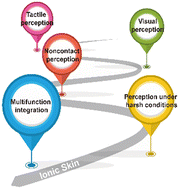Ionic skin: from imitating natural skin to beyond
Abstract
Ionic skin, as an emerging subclass of artificial skin, has been proposed and developed for nearly a decade, which makes up for the partial shortcomings of electronic skin to some extent. Highly similar to the ion-sensing mechanism of natural skin, the ionic skin also acquires and conducts perceptual signals in the form of ions. During this decade, a great deal of effort has been devoted to the species amplification of ionic soft matter and the discovery of new mechanisms of artificial ion sensing. It is worth emphasizing that the deciphering of the perceptual mechanisms of natural skin has inspired a great number of bionic studies in pursuit of the reproduction of natural touch in ionic skin. Ionic skin, as a multi-functional operating platform, is also endowed with attractive functions that are beyond natural skin. The birth and appearance of ionic skin greatly promote the vigorous development of products in the era of the internet of things, such as human-machine interaction, prosthetics and wearable devices. In this review, on the basis of explaining the perceptual mechanism of natural skin, we deeply analyze the progressive sensing mechanism of bionic ionic skin. The typical cases of ionic skin that are beyond the ability of natural skin are also summarized in detail. Finally, constructive perspectives and common issues are presented for the future development of ionic skin.
Keywords: Ionic skin; Tactile perception; Bionic; Flexible sensor.

- This article is part of the themed collections: Virtual Collections—ICM HOT Papers and Virtual Collections—ICM Reviews


 Please wait while we load your content...
Please wait while we load your content...